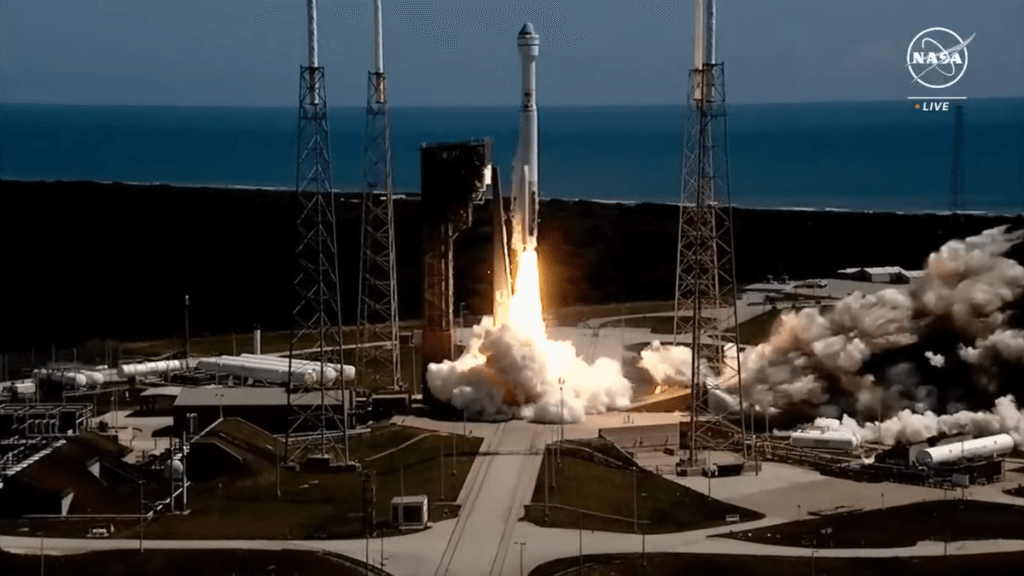Update: June 5, 11:02 a.m. ET: ULA’s Atlas V rocket blasted off this morning at 10:52 a.m. ET, with NASA astronauts Butch Wilmore and Suni Williams sitting inside Boeing’s Starliner capsule. The first crewed mission of this spacecraft, following two failed launch attempts, is finally underway. Of course, the true test of Starliner is not the launch, but how it performs in space.
Update: June 5, 7:15 a.m. ET: As ULA tweets, its Atlas V rocket is now fully fueled and set for today’s launch, while astronauts Butch Wilmore and Suni Williams are putting on their spacesuits and preparing to head to the launch pad. ULA is still targeting 10:52 a.m. ET for today’s launch attempt.
Update: June 4, 11:42 p.m. ET: The launch attempt on June 1 had to scrubbed due to a rocket issue, specifically a faulty ground power unit that was subsequently replaced. United Launch Alliance (ULA) is now targeting a launch at 10:52 a.m. ET on Wednesday, June 5. The weather forecast shows a 90% chance of favorable weather conditions for launch. You can tune in to the live feed, which starts at 6:45 a.m. ET, below.
The crewed Starliner spacecraft is scheduled to dock at the forward-facing port of the ISS’s Harmony module at roughly 12:15 p.m. ET on Thursday, June 6.
Despite several delays and technical hiccups, Boeing is getting ready to launch its first crewed test flight to the International Space Station (ISS) as part of its agreement with NASA.
Boeing’s Starliner spacecraft is set for launch on Saturday, June 1 at 12:25 p.m. ET from Cape Canaveral Space Force Station in Florida. The crew capsule will ride atop United Launch Alliance’s Atlas V rocket, carrying NASA astronauts Butch Wilmore and Suni Williams to the space station and back.
NASA will broadcast the launch live on its website and the space agency’s YouTube channel. The launch coverage will begin at 8:15 a.m. ET. Boeing will also be airing the launch live through its website.
It’s been a nail-biting journey to make it to this point, and frankly the upcoming launch has us quite anxious. The company was originally targeting May 6 for the liftoff of Starliner but a last minute anomaly with one of the Atlas V rocket’s pressure valves delayed the crewed test flight to May 17. Just days before the launch, however, Starliner teams detected a small helium leak in the spacecraft’s service module, prompting them to push the launch to May 21 before it was delayed indefinitely.
Earlier this week, Boeing announced that it decided to proceed with flying the astronaut crew on the leaky Starliner spacecraft without resolving the issue. Boeing’s vice president Mark Nappi said that fixing the leak would require taking apart the Starliner spacecraft at its factory, AFP reported. Instead, Starliner teams will monitor the leak ahead of the launch on Saturday.
Starliner’s first uncrewed test flight in 2019 managed to reach space, but a software automation glitch caused the spacecraft to burn excess fuel, preventing it from making it to the ISS. Starliner miscalculated its location in space due to a glitch caused by a faulty mission elapsed timer.
The botched first flight prompted NASA to call for a second test flight of the empty spacecraft before a crew rides on board. In May 2022, Boeing completed the Orbital Flight Test-2 (OFT-2), the second uncrewed test flight of Starliner, setting the stage for a crewed test flight. But OFT-2 suffered a few hiccups, including the failure of a thruster used for orbital maneuvering.
Boeing’s crewed Starliner launch was initially set for February 2023, then postponed to late April, and finally rescheduled for July 21, 2023. A few weeks before liftoff, however, the company announced that it was standing down from the launch attempt to address newfound issues with the crew vehicle, including a mile’s worth of flammable tape that had to be manually removed.
Despite all of these failures, NASA remains dedicated to the Starliner program and having two commercial partners transporting its astronauts to low Earth orbit. With the leaky spacecraft, Saturday’s launch is a major test of NASA’s relationship with its entourage of private companies.


